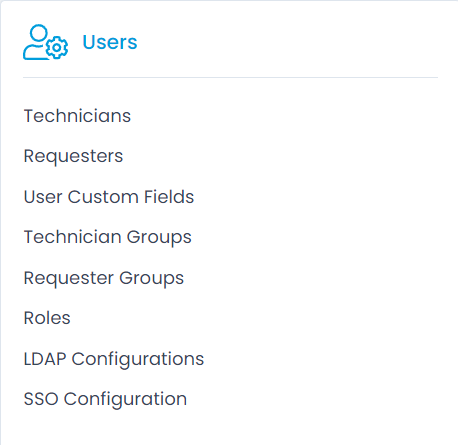Users
This section provides settings to view, add, manage, and define the characteristics of the application users. You can also assign roles and responsibilities, import users, and configure SSO using various services. The section has the following components:
- Technicians: A Technician delivers the IT services with the help of certain access rights to process the different requests. All the technicians are associated with a specific role that defines their access level.
- Requesters: The Requesters seek information or raise requests through this platform. These users have access to the request management, approvals, and the knowledge management modules. They can also view the changes and assets assigned to them based on the assigned permissions.
- User Custom Fields: Custom User fields capture the additional details about the users. These fields can be used in the automation settings.
- Technician Groups: Technician Groups include people with similar qualities or handling same kind of responsibilities. For example, an IT Team, Support Team, Customer Handling Team, etc. Each Group is associated with a set of technicians. A technician can also be in different groups.
- Requester Groups: A Requester Group is a set of people who are dedicatedly assigned for raising requests for various issues or requirements. This group of people can be converted to technicians too.
- Roles: Roles are the group of access rights or permissions for the users. They can be broadly classified as Super Admin, Technician, or Requester. Roles show the hierarchy of available editing privileges.
- LDAP Configurations: ServiceOps allows to upload a list of Requesters or Technicians in bulk through the LDAP Request. LDAP is a protocol used to access a distributed directory of the internal employees. The email clients mainly use it for a bulk update.
- SSO Configuration: ServiceOps uses the single user management system. It allows the employees to use their corporate account to login to third-party services without creating separate accounts or remembering multiple passwords. This is called SSO (Single Sign On).
